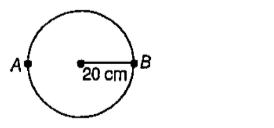A particle moves on a circular path of radius 'r'. It completes one revolution in 40s. Calculate distances displacement in 2 min 20 s.
To solve the problem, we will follow these steps:
Step 1: Convert the time from minutes and seconds to seconds.
The total time given is 2 minutes and 20 seconds.
- Convert 2 minutes to seconds:
2 minutes=2×60=120 seconds
- Add the additional 20 seconds:
Total time=120 seconds+20 seconds=140 seconds
Step 2: Determine the number of complete revolutions.
The particle completes one revolution in 40 seconds.
- To find the number of revolutions in 140 seconds:
Number of revolutions=140 seconds40 seconds/revolution=3.5 revolutions
This means the particle completes 3 full revolutions and half of another revolution.
Step 3: Calculate the displacement.
After completing 3 full revolutions, the displacement is zero because the particle returns to its starting point. For the half revolution:
- The displacement for half a revolution is equal to the diameter of the circle:
Displacement=2r
Step 4: Calculate the total distance traveled.
The distance traveled can be calculated by considering the distance for the complete revolutions and the distance for the half revolution:
- Distance for 3 full revolutions:
Distance for 3 revolutions=3×2πr=6πr
- Distance for half a revolution:
Distance for half revolution=πr
- Total distance:
Total distance=6πr+πr=7πr
Final Results:
- Distance = 7πr
- Displacement = 2r
The total time given is 2 minutes and 20 seconds.
- Convert 2 minutes to seconds:
2 minutes=2×60=120 seconds
- Add the additional 20 seconds:
Total time=120 seconds+20 seconds=140 seconds
The particle completes one revolution in 40 seconds.
- To find the number of revolutions in 140 seconds:
Number of revolutions=140 seconds40 seconds/revolution=3.5 revolutions
This means the particle completes 3 full revolutions and half of another revolution.
After completing 3 full revolutions, the displacement is zero because the particle returns to its starting point. For the half revolution:
- The displacement for half a revolution is equal to the diameter of the circle:
Displacement=2r
The distance traveled can be calculated by considering the distance for the complete revolutions and the distance for the half revolution:
- Distance for 3 full revolutions:
Distance for 3 revolutions=3×2πr=6πr
- Distance for half a revolution:
Distance for half revolution=πr
- Total distance:
Total distance=6πr+πr=7πr
- Distance = 7πr
- Displacement = 2r
Topper's Solved these Questions
- KINEMATICS (MOTION ALONG A STRAIGHT LINE AND MOTION IN A PLANE)BOOK - ALLENCHAPTER - KINEMATICS (MOTION ALONG A STRAIGHT LINE AND MOTION IN A PLANE)EXERCISE - BEGINNER S BOX-2
7 Videos
- KINEMATICS (MOTION ALONG A STRAIGHT LINE AND MOTION IN A PLANE)BOOK - ALLENCHAPTER - KINEMATICS (MOTION ALONG A STRAIGHT LINE AND MOTION IN A PLANE)EXERCISE - BEGINNER S BOX-3
2 Videos
- KINEMATICS (MOTION ALONG A STRAIGHT LINE AND MOTION IN A PLANE)BOOK - ALLENCHAPTER - KINEMATICS (MOTION ALONG A STRAIGHT LINE AND MOTION IN A PLANE)EXERCISE - BEGINNER S BOX-7
8 Videos
- KINEMATICSBOOK - ALLENCHAPTER - KINEMATICSEXERCISE - Integer Type Question
3 Videos
- MISCELLANEOUSBOOK - ALLENCHAPTER - MISCELLANEOUSEXERCISE - SUBJECTIVE QUESTION
9 Videos
Similar Questions
Knowledge Check
A cyclist moving on a circular track of radius 40 m completes half a revolution in 40 s. Its average velocity is
AzeroB4πms−1C2ms−1D8πms−1A body move in a circular path of radius 20 cm. If it completes two and a half revolution along the circular path, the distance and displacement of the body are
 A40 cm,0B314 cm,0C314 cm, 40 cmD628 cm, 314 cm
A40 cm,0B314 cm,0C314 cm, 40 cmD628 cm, 314 cmA cyclist moving on a circular track of radius 40 m completes half a revolution in 40 sec. Its average velocity is :
AzeroB4πm/s2C2m/s,D8πm/s
A cyclist moving a car circular track of raidus 40 cm completes half a revolution in 40 s. Its average velocity is
View SolutionA particle is moving in a circular path of radius 'r'. The displacement after half a circle would be
View SolutionA particle is moving on a cicular path of radius 'R' . As it moves through an angular displacement θ, its linear displacement will be :
View SolutionA particle is moving in a circular path of radius r. The displacement after half a circle would be
View SolutionA particle is moving in a circular path of radius r. The displacement after half a circle would be
View Solution
